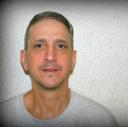ABC News
Aug. 19 — Greg Wilhoit remembers his desperation as he was brought in to his cellblock at the State Penitentiary in McAlester, Okla.
I thought, My life’s over, literally over,” he says. As prisoner 100841, Wilhoit faced the death penalty after a jury found him guilty in 1987 of his wife’s murder.
A year later, Ron Williamson — Wilhoit’s new neighbor across the hall in cellblock F — could not believe he was living among killers. “I’ve never been so miserable in my entire life, being down there among those murderers and never having ever killed anybody,” he says.
McAlester’s death row is a grim place; since 1990, 30 men have been executed there. For most, the only way out is by dying.
But these two men found another way. Like most inmates on death row, Wilhoit and Williamson argued they were innocent. And their determination to prove it became the basis for an unusual bond that would ultimately save their lives.
Learning to Trust
Wilhoit’s nightmare began in 1985 when his wife Kathryn was beaten and strangled. Neighbors found her body when they responded to the cries of the couple’s two infant daughters. Wilhoit, an ironworker, had recently separated from Kathryn, and although he insisted on his innocence he had no alibi on the night of the crime. He was found guilty and sent to death row.
Williamson was also convicted of a brutal killing. Once a star baseball player — promising enough to be drafted by the Oakland A’s organization — an injury ended his career. His path to death row began in 1982, when Debra Carter, a 22-year-old waitress, was found raped and strangled in her apartment in Ada, Okla. A loner in town, with a police record and mental problems, Williamson became the target of the investigation. Five years after the crime he and a co-defendant were convicted, and Williamson arrived at McAlester in 1988.
When he first arrived to cellblock F — where violent attacks from
fellow convicts were a constant threat — Williamson kept to himself. After a while, Wilhoit says they started to have small conversations. From those conversations behind bars, the fear and suspicion central to prison life slowly turned to a friendship.
“Our friendship evolved enough where we felt comfortable with each other to go out in the yard,” Wilhoit says.
Over time, their bond and trust deepened. “We didn’t hide anything from one another,” Williamson says.
They also became convinced of each other’s innocence. After poring over the 5,000 page transcript of Williamson’s trial, Wilhoit says he thought his friend had been railroaded. In Wilhoit’s case, the testimony of two dentists — expert witnesses for the prosecution — convinced the jury that a bite mark on the body of his murdered wife came from him. After a two-week trial, he was found guilty of first-degree murder, and the jury recommended the death penalty.
Lucky Break
Wilhoit suffered on death row for more than four years. His only hope was Mark Barrett, the public defender handling his appeal. Barrett says Wilhoit’s main problem was his first lawyer’s incompetence.
“His lawyer was the town drunk by the time of Wilhoit’s trial,” Barrett says. “Enough of a town drunk that he had wet himself in some court rooms, [and] thrown up in the judge’s chambers.”
For years, Barrett fought to have the bite mark re-tested. Finally, 11 top forensic specialists reached a unanimous conclusion — there was no match. In 1993, Wilhoit was granted a new trial. Once again, the prosecution said he had brutally killed his wife. But this time, there was no evidence to back it up. Halfway through, the judge stopped the proceedings and set Wilhoit free.
Meanwhile, time was running out for Ron Williamson. His sister even received a letter from the prison describing the correct procedure to claim his body. But when things seemed most desperate, Williamson got a break. Barrett, the same public defender who got Wilhoit released, helped pinpoint critical mistakes in Williamson’s conviction.
“Ron’s case and Greg’s case are greatly similar in that they had bad scientific evidence and bad lawyering that was ultimately made somewhat right through better scientific evidence,” Barrett says.
For Williamson, stray hairs were at the center of the prosecution’s case against him. Twelve years earlier, a few strands of hair found on the victim had been linked to Williamson and his co-defendant simply by the way they looked under a microscope. But in 1999, the DNA within the hairs was examined and Barrett and co-counsel Barry Scheck proved their clients were innocent. With his friend Greg Wilhoit standing in the courtroom, and after enduring more than a decade in prison, Williamson was finally told he was free to go.
Today, the two former prison buddies have rekindled their friendship on the outside. And even though they both lived through years of injustice, they are overwhelmingly thankful — for their friendship and for life. Recently, after visiting McAlester with Williamson and 20/20, Wilhoit summed it all up. “It’s such a good feeling to know that I can leave whenever I want to,” he said. “And I can take my buddy Ron with me.”



